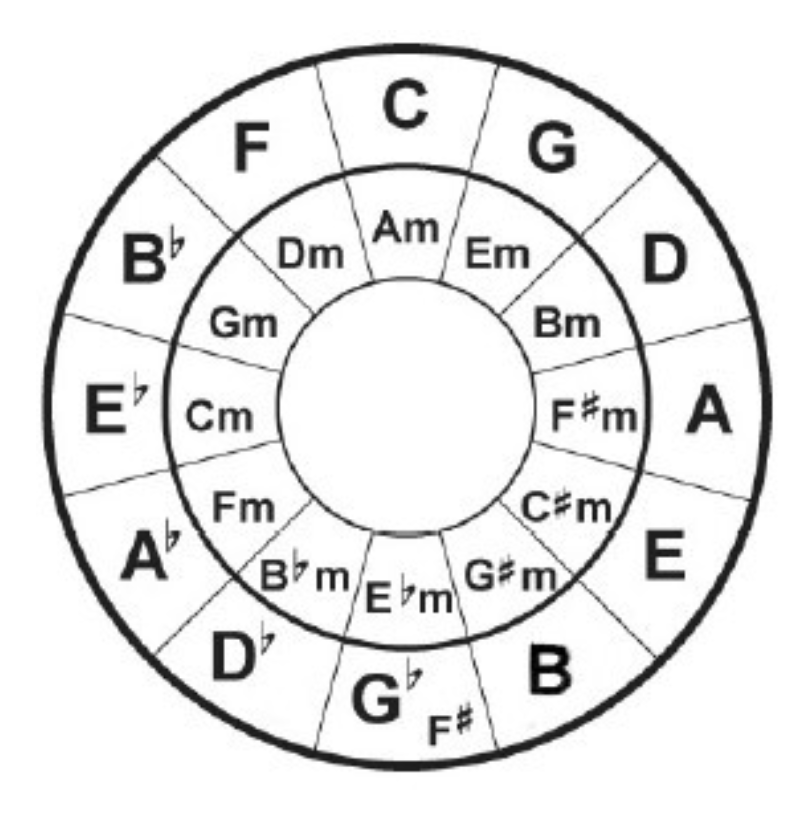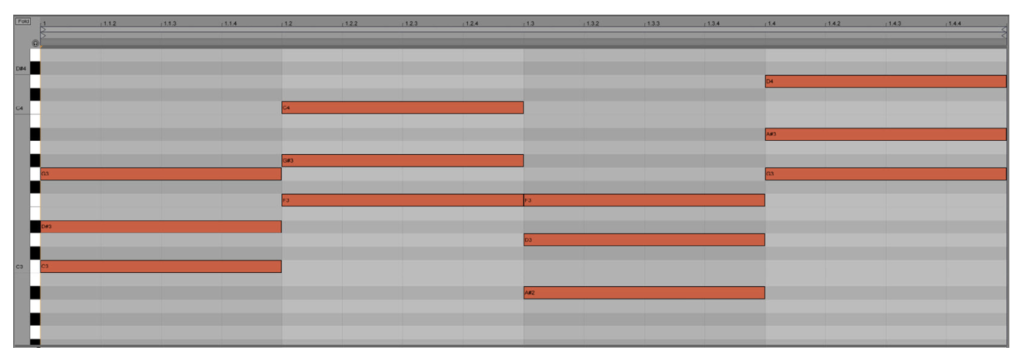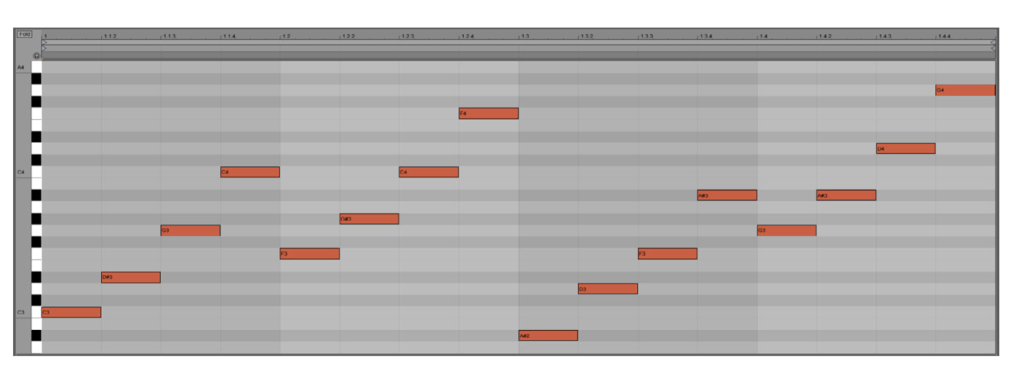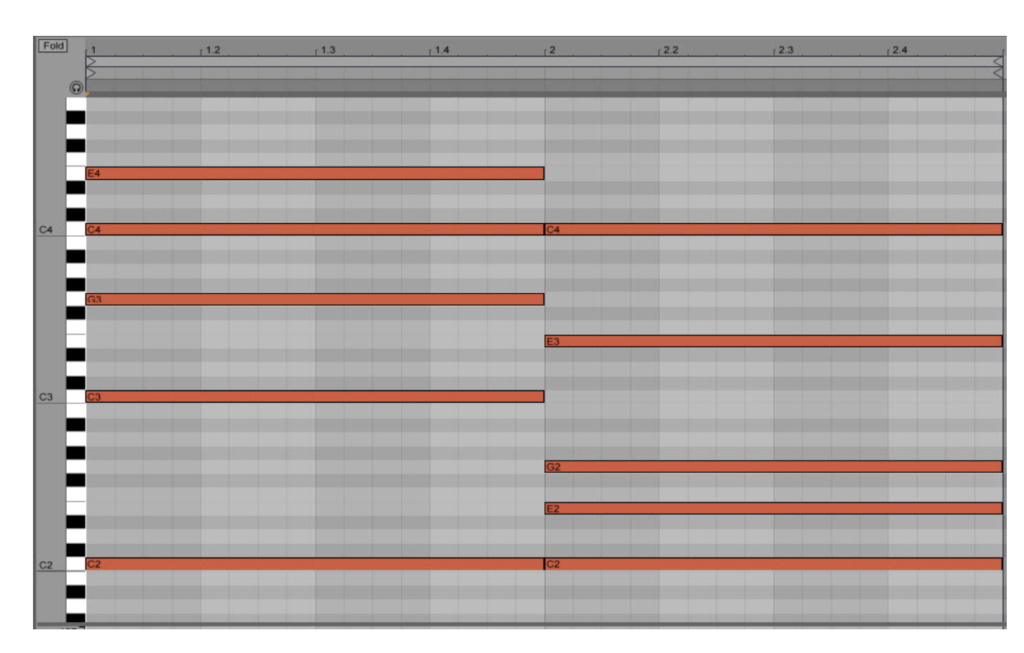This is intended for my personal use only and they are NOT guaranteed to be 100% correct
reference:
https://www.amazon.com/Music-Theory-Electronic-Producers-progressions/dp/069209329X
Notes, Scales, Keys
- Scale is a way to organize notes into forming a key.
- Most common scales minor scale and major scale.
- For each key, it has a “center” where it is based on, called tonal center.
- Major / minor key formation:
- Major scale: 2, 2, 1, 2, 2, 2, 1(return to beginning)
- Minor scale: 2, 1, 2, 2, 1, 2, 2(return to beginning), shifted 2 positions from major
* 2 is move up 2 notes, called **full step** * 1 is a **half step** - It’s formed like this because notes sound good in this way
- The ONLY way to tell a key is Major or minor is to follow that sequence, something starts with G could actually be C major key
- Relative keys:
- For a major key, it has a related minor key that uses completely all the same notes but sounds different.
- Major -> minor: find 6th note and take its minor key
- minor -> major: move up 3 steps
Intervals
- Perfect Fifth:
- Root + 5th.
- It’s perfect because the frequency ratio is 2:3 and is considered consonant
- Notes with perfect 5 added have more “power” to it and sounds more “rich”
- Perfect Fourth:
- Root + 4th (Inverted 5th)
- By itself, it has a tendency to fall to 3rd.
- 6th & 3rd:
- have the power to determine if the current chord is major or minor
- How inversion works in interval:
- [Interval + x = 9] where x is the inverted interval, and the major/minor quality of the interval changes.
- Eg: minor 6th <–> Major 3rd
- Except 5th and 4th: Perfect 5th <–> Perfect 4th
- [Interval + x = 9] where x is the inverted interval, and the major/minor quality of the interval changes.
Chords
- For each key, it has a sequence of notes being played that loops (For C Major, it’s CDEFGAB)
- On each note of that sequence, there is a related chord that derives from the key ON that note.
- The quality of the chord has NOTHING TO DO with quality of the key we are currently using
- Notes DO NOT NEED to be in the area on keyboards (C1-B2, C2-B3, …)
- V in C major can be C3, E3, G3 or E3, G3, C4 or G2, C3, E3 …
Triads (Chords built on 3 notes)
- Types:
- Major chord: root + 3rd + 5th of the Major key that is using root as tonal center. Denoted by M
- Minor chord: root + 3rd + 5th of the minor key that is using root as tonal center. Denoted by m
- Diminished chord: root + 3rd + diminished 5th (a normal 5th down a step). Not widely used. Denoted by dim
- In each key, for note I to VI, the quality (major / minor) of chord follows this pattern:
- For Major key: M – m – m – M – M – m – dim – M – …
- For minor key: m – dim – M – m – m – M – M – m, shifted 2 positions from major
- Otherwise, it is unpleasant to hear.
- Inversion in triads
- What and why
- Reordering notes in a given chord
- This can help create a smoother upward/downward transition between chords
- make the change in notes during a chord progression as little as possible
- Types:
- First inversion: move I up an octave. Represented by subscript 6
- Second inversion: move V down an octave / I, III up an octave. Represented by subscript 6/4
7th chords
- Use root, 3rd, 5th, 7th
- Types:
- Major 7th:
- If the base triad is a major chord, follow the major key and add 7th note of that major key
- add 4 steps from V to get VII, 11 steps from root
- Maj7
- Minor 7th:
- If the base triad is a minor chord, follow the minor key and add 7th note of that minor key
- add 3 steps from V to get VII, 10 steps from root
- min7
- Dominant 7th:
- When base is a major chord but a minor 7th is added
- “Dominant” because it has a strong tendency to fall back to a more tonic state
- A strong tendency to “resolute” to a more tonic chord.
- Makes people feel alerted?
- Each dominant 7th is related to a particular key.
- Represented by 7
- Psycho chord:
- Mainly used in a movie called Psycho
- When base is a minor chord but a major 7th is added
- Not widely used in diatonic chord progression.
- Represented by mM7
- Again, this has a pattern similar to that of triad:
- For Major keys: Maj7 – min7 – min7 – Maj7 – 7 – min7 – dim7 – Maj7
- For minor keys: min7 – dim7 – Maj7 – min7 – min7 – Maj7 – 7 – min7, shifted 2 positions from major
Alternations to chords
- Suspended chords: substitude 3rd with 2nd or 4th
- Add chords: add 2nd or 4th to current chord
- Can also add a major/minor 9th
- ->, up, down / ->, down, up
- ->, down, down / ->, up, up
- ->, down, up2 / ->, up, down2
Roman representation of chords
- Major Triads:
- M – m – m – M – M – m – dim – M
- I – ii – iii – IV – V – vi – vii^o – I
- i – ii^o – III – iv – v – VI – VII – i for minor triads
- Capitalized numbers: 1, 4, 5 are only in Major triads; 3, 6, 7 are only in minor triads
- Major 7th chords:
- Maj7 – min7 – min7 – Maj7 – Dom7 – min7 – dim7 – Maj7
- I7 – ii7 – iii7 – IV7 – V7 – vi7 – vii^o7 – I7
- i7 – ii^o7 – III7 – iv7 – v7 – VI7 – VII7 – i7 for minor 7th chords
- Capitalized numbers: 1, 4, 5 are only in Majors where 5 is Dominant; 3, 6, 7 are only in minors where 7 is Dominant
- Chord progression is represented by linking the chords with their corresponding roman numbers
- For a given chord pregression, it sounds similar regardless of the current key being used
Linking chords together:
- Cadences: short combinations of chords
- Authentic: V – I
- Plagal: IV – I
- Half: (…) – V
- Sets the tension
- Deceptive: V – (…)
- Creates twist
- Common progressions:
- I, IV, V
- I, vi, IV, V
- ii, V, i
- I, vi, ii, V
- I, V, vi, IV
- I, IV, vi, V
- I, iii, IV, V
- I, IV, I, V
- I, IV, ii, V
- Borrowing:
- For I, vi, ii, V in C major (CM, Am, Dm, GM), Dm can be seen as I of D minor, thus a V of that I can be added (substitute AM with A7), the finalized progression can be (CM, Am, A7, Dm, GM)
- Use the chords of same number in parallel key (CM <–> Cm, DM <–> Dm, …)
- Substitution:
- V can be substituted with (G, B, D)
- bII, the Major chord of 2nd down half a step. Tritonic substitution / Napolitan 6th (Db, F, Ab)
- V7 (G, B, D, F)
- Vaug (G, B, D#)
- Vº7 (G, Bb, Db, E)
- V can be substituted with (G, B, D)
Special chords
- Napolitan chord
- bII (replaces II or IV) -> V -> I
- Picardy 3rd in minor keys:
- V -> I, instead of V -> i
- Sus chords
- Make 3rd to be 2nd or 4th
Modded minor scale
- Minor scales are sometimes changed in some ways because 5th related chords sound good
- (inverted) V-I is good because:
- It has a 7th, which has a strong tendency to fall to 1st
- It has a 5th to 1st motion
- shared 5th
- Changed by moving 7th up a half step, and all the chords that used that 7th is changed, resulting in changes in chord patterns:
- Changed to m – º – + – m – M – M – º – m
- Where + is moving the 5th in that major triad up a half step
- When building melodies, 6th is also raised half a step to avoid the gap btwn 6th and 7th being to big
Circle of 5ths

- It can show how “similar” are two keys
- “similar” in the sense of sharing same notes
- The most similar keys are always a 5th away, hence the name
- Can choose chords in similar keys when needed
- But not changing keys
Accompaniment styles
- Arpeggios: play notes in chord one at a time, or add a 4th one. 4th one can be 3rd or 1st up an octave


- Large gaps after arpeggiation can be solved by inversion
- Can get automated by auto arpeggiators, only input is chord itself
- Arpeggiated inversions:

- Steady rhythm:

Dissonance

- Intervals that creates some sort of tention
- Can add notes to chords to desired dissonance level
- Tritone is most dissonate because it’s nowhere in minor/major scale at all
Texture & Density
- big space at bottom -> small space on top: thick (left)
- small space at bottom -> big space on top: thin (right)

- space can be adjusted by using inversions and octaves and stuff
- Changing number of notes can also make chords thicker
Other scales:

- Ionian: Major scale
- Dorian: Minor scale with a raised 6th degree. btwn Major and minor scales
- Phyrigian: minor scale with a lowered 2nd degree. More eerie than minor
- Lydian: Major scale with a raised 4th degree. Super major
- Mixolydian: Major scale with a lowered 7th scale
- Aeolian: Minor scale
- Locrian: minor scale with lowered 2nd and 5th degree
Comments are closed